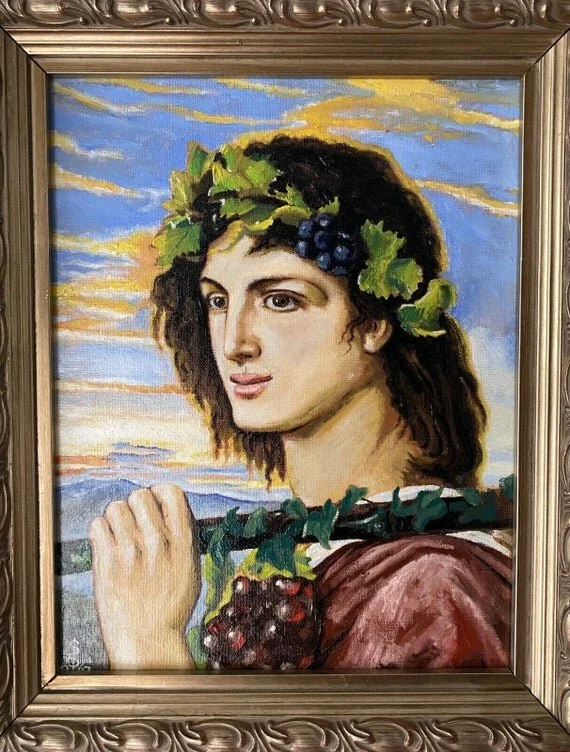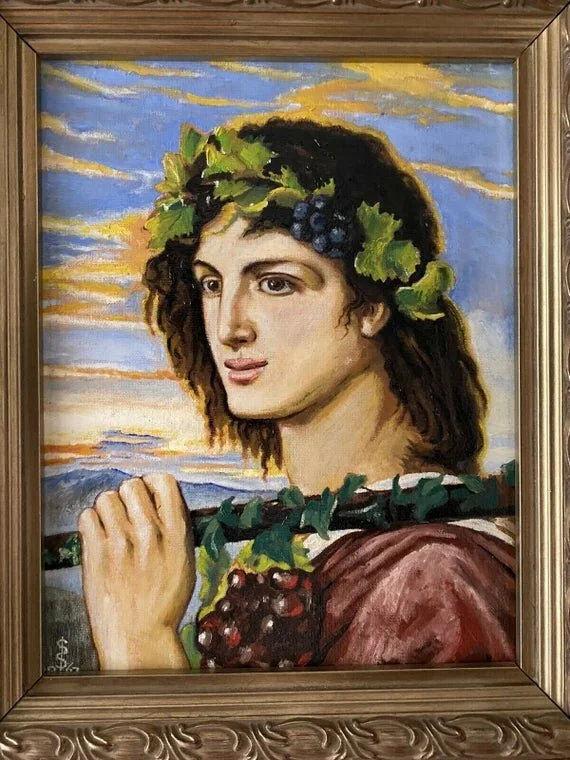Pre-Raphaelite Style Oil Painting Simeon Solomon Bacchus Dionysus Gay roman Greek PreRaphaelite
Pre-Raphaelite Style Oil Painting Simeon Solomon Bacchus Dionysus Gay roman Greek PreRaphaelite
A$1,850.00
Bacchus, after Simeon Solomon
This is an astounding and stunning hand-painted oil on canvas after the celebrated victorian artist Simeon Solomon.
The original in the Walker art museum Liverpool UK was painted in 1867. We believe this is a later copy.
The painting is beautifully framed in a large and heavy solid carved wooden frame in rubbed silver.
Dimensions: 14" x 11" (36 x 28 cm) Framed 21 x 18 (54 x 46.5 cm)
"Solomon’s fascination with Bacchus led to the creation of at least three significant pictures inspired by the Roman God of Wine. The first was painted in 1865 and is now lost but the second, an oil from 1867, has become one of Solomon’s best-known pictures (Birmingham City Art Gallery). The oil was exhibited at the Royal Academy whilst the present watercolour, the third of the series, was sent to the Dudley Gallery exhibition at the Egyptian Hall on Piccadilly. It was accompanied by lines from William Morris’ Life and Death of Jason; ‘By thee the unnamed smouldering fire Within our hearts turns to desire, Sweet, amorous, half-satisfied; Through thee the doubtful years untried Seem fair to us an fortunate, In spite of death, in spite of fate.’"
Artist:
Simeon Solomon (9 October 1840 – 14 August 1905) was an English painter associated with the Pre-Raphaelites and Orientalists who was noted for his depictions of Jewish life[1] and same-sex desire.
Biography:
Solomon was born into a prominent Jewish family. He was the eighth and last child born to merchant Michael (Meyer) Solomon and artist Catherine (Kate) Levy. Solomon was a younger brother to fellow painters Abraham Solomon (1824–1862) and Rebecca Solomon (1832–1886).
Born and educated in London, Solomon started receiving lessons in painting from his older brother around 1850. He started attending Carey's Art Academy in 1852. His older sister first exhibited her works at the Royal Academy during the same year.
As a student at the Royal Academy Schools, Solomon was introduced through Dante Gabriel Rossetti to other members of the Pre-Raphaelite circle, as well as the poet Algernon Charles Swinburne and the painter Edward Burne-Jones in 1857. His first exhibition was at the Royal Academy in 1858. He continued to hold exhibitions of his work at the Royal Academy between 1858 and 1872. In addition to the literary paintings favoured by the Pre-Raphaelite school, Solomon's subjects often included scenes from the Hebrew Bible and genre paintings depicting Jewish life and rituals. His association with Swinburne led to his illustrating Swinburne's controversial novel Lesbia Brandon in 1865.
In 1873, Simeon was arrested for "cruising public restrooms" and having sex with a 60-year-old stableman named George Roberts. Both men were charged with indecent exposure and an attempt to commit "buggery." Both were found guilty, fined 100 pounds and sentenced to 18 months of hard labor. He was arrested again in 1874 in Paris, after which he was sentenced to spend three months in prison.
After his prosecutions he no longer exhibited, but achieved a degree of celebrity amongst those who shared his sensibilities: Oscar Wilde, John Addington Symonds, Count Eric Stenbock, and Walter Pater all collected his works.
In 1884 he was admitted to the workhouse where he continued to produce work, but his life and talent were blighted by alcoholism. Twenty years later in 1905, he died from complications brought on by his alcoholism. He was buried at the Jewish Cemetery in Willesden.
Examples of his work are on permanent display at the Victoria and Albert Museum, Wightwick Manor in Wolverhampton, and at Leighton House in west London. Retrospectives of his work have been held at the Birmingham Museum and Art Gallery in 2005–6, and in London at the Ben Uri Gallery in 2006.
This is an astounding and stunning hand-painted oil on canvas after the celebrated victorian artist Simeon Solomon.
The original in the Walker art museum Liverpool UK was painted in 1867. We believe this is a later copy.
The painting is beautifully framed in a large and heavy solid carved wooden frame in rubbed silver.
Dimensions: 14" x 11" (36 x 28 cm) Framed 21 x 18 (54 x 46.5 cm)
"Solomon’s fascination with Bacchus led to the creation of at least three significant pictures inspired by the Roman God of Wine. The first was painted in 1865 and is now lost but the second, an oil from 1867, has become one of Solomon’s best-known pictures (Birmingham City Art Gallery). The oil was exhibited at the Royal Academy whilst the present watercolour, the third of the series, was sent to the Dudley Gallery exhibition at the Egyptian Hall on Piccadilly. It was accompanied by lines from William Morris’ Life and Death of Jason; ‘By thee the unnamed smouldering fire Within our hearts turns to desire, Sweet, amorous, half-satisfied; Through thee the doubtful years untried Seem fair to us an fortunate, In spite of death, in spite of fate.’"
Artist:
Simeon Solomon (9 October 1840 – 14 August 1905) was an English painter associated with the Pre-Raphaelites and Orientalists who was noted for his depictions of Jewish life[1] and same-sex desire.
Biography:
Solomon was born into a prominent Jewish family. He was the eighth and last child born to merchant Michael (Meyer) Solomon and artist Catherine (Kate) Levy. Solomon was a younger brother to fellow painters Abraham Solomon (1824–1862) and Rebecca Solomon (1832–1886).
Born and educated in London, Solomon started receiving lessons in painting from his older brother around 1850. He started attending Carey's Art Academy in 1852. His older sister first exhibited her works at the Royal Academy during the same year.
As a student at the Royal Academy Schools, Solomon was introduced through Dante Gabriel Rossetti to other members of the Pre-Raphaelite circle, as well as the poet Algernon Charles Swinburne and the painter Edward Burne-Jones in 1857. His first exhibition was at the Royal Academy in 1858. He continued to hold exhibitions of his work at the Royal Academy between 1858 and 1872. In addition to the literary paintings favoured by the Pre-Raphaelite school, Solomon's subjects often included scenes from the Hebrew Bible and genre paintings depicting Jewish life and rituals. His association with Swinburne led to his illustrating Swinburne's controversial novel Lesbia Brandon in 1865.
In 1873, Simeon was arrested for "cruising public restrooms" and having sex with a 60-year-old stableman named George Roberts. Both men were charged with indecent exposure and an attempt to commit "buggery." Both were found guilty, fined 100 pounds and sentenced to 18 months of hard labor. He was arrested again in 1874 in Paris, after which he was sentenced to spend three months in prison.
After his prosecutions he no longer exhibited, but achieved a degree of celebrity amongst those who shared his sensibilities: Oscar Wilde, John Addington Symonds, Count Eric Stenbock, and Walter Pater all collected his works.
In 1884 he was admitted to the workhouse where he continued to produce work, but his life and talent were blighted by alcoholism. Twenty years later in 1905, he died from complications brought on by his alcoholism. He was buried at the Jewish Cemetery in Willesden.
Examples of his work are on permanent display at the Victoria and Albert Museum, Wightwick Manor in Wolverhampton, and at Leighton House in west London. Retrospectives of his work have been held at the Birmingham Museum and Art Gallery in 2005–6, and in London at the Ben Uri Gallery in 2006.





